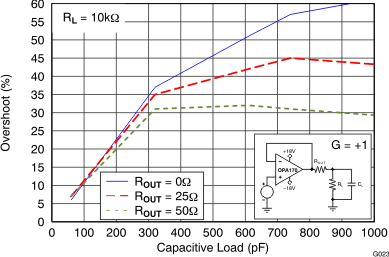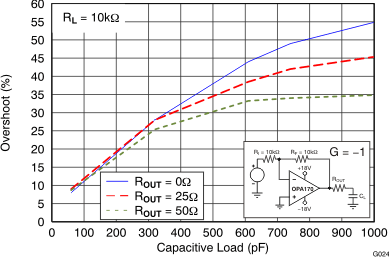JAJSFT1E August 2011 – April 2018 OPA170 , OPA2170 , OPA4170
PRODUCTION DATA.
- 1 特長
- 2 アプリケーション
- 3 概要
- 4 改訂履歴
- 5 Device Comparison Table
- 6 Pin Configuration and Functions
- 7 Specifications
- 8 Detailed Description
- 9 Application and Implementation
- 10Power Supply Recommendations
- 11Layout
- 12デバイスおよびドキュメントのサポート
- 13メカニカル、パッケージ、および注文情報
パッケージ・オプション
メカニカル・データ(パッケージ|ピン)
サーマルパッド・メカニカル・データ
- D|8
発注情報
8.3.4 Capacitive Load and Stability
The dynamic characteristics of the OPAx170 have been optimized for common operating conditions. The combination of low closed-loop gain and high capacitive loads decreases the phase margin of the amplifier and can lead to gain peaking or oscillations. As a result, heavier capacitive loads must be isolated from the output. The simplest way to achieve this isolation is to add a small resistor (for example, ROUT equal to 50 Ω) in series with the output. Refer to Figure 39 and Figure 40 illustrate graphs of small-signal overshoot versus capacitive load for several values of ROUT. Also, refer to applications bulletin AB-028, Feedback Plots Define Op Amp AC Performance, for details of analysis techniques and application circuits.

| 100-mV Output Step | G = 1 |

| 100-mV Output Step | G = –1 |